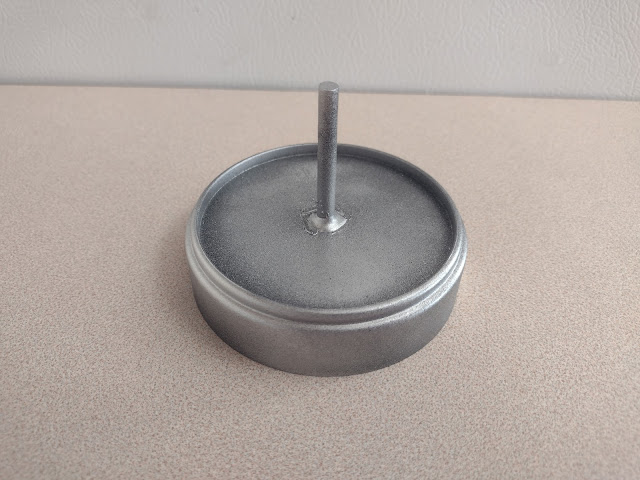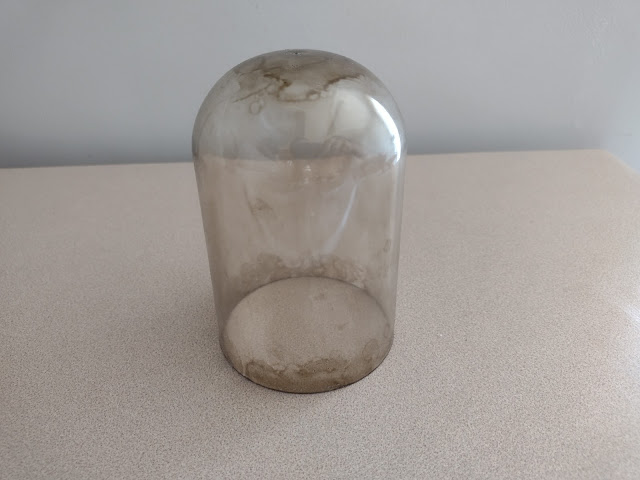$30 - $40 (based on 2023 prices)
Makes one lamp
In 2023, I was commissioned by a local theater to serve as a consultant and prop builder for their production of The Haunting of Hill House, which was based on Shirley Jackson’s novel. Being a fan of the books since I was a teenager, I jumped at the opportunity and spent several months creating a collection of items to decorate both the house depicted on the stage and the cemetery created in the lobby to greet patrons before they entered the theater. For this prop, I fashioned a decorative lamp to adorn one of the tables in the Hill House set. To keep the cost down, I bought the lamp stand and shade at a second-hand store and used a set of winged skeletons I purchased on clearance the prior year.
- One twenty-four-inch base for a table-top lamp
- Two eighteen-inch winged skeletons
- One 10 oz. can of interior/exterior, fast-drying spray paint in flat black*
- One 2 oz. bottle of acrylic paint in flat orange*
- One 2 oz. bottle of acrylic paint in flat turquoise*
- One 2 oz. bottle of acrylic paint in metallic copper*
- Two to three Halloween-themed paper napkins
- One 4 oz. bottle of decoupage medium
- One 10” x 12” lamp shade
- Two to three yards of black ribbon
- Two to three yards of black fringe tassel trim
1. After removing any decorative elements from the lamp base, thoroughly wash and dry the item. If there is any sticker residue, use rubbing alcohol to remove it (soak a paper towel in the solution, let it sit over the area for a few minutes, and wipe away the remaining glue).2. Separate the arms and legs from the skeletons and cut their joints. Then, arrange the figures on the lamp’s base. By cutting the joints, you can position them into poses that are more natural, allowing them to hug the post. Once you have achieved your desired look, glue the skeletons in place. I used hot glue, but you can use superglue for a sturdier hold.
3. Cover the electrical cord in a plastic bag and use painter’s tape to cover the light socket to prevent paint from ruining the wiring. Following this, give the prop an even coat of black spray paint. Since this will become the base for the aged patina, you will only need one to two coats because much of it will be covered by the other hues.
4. Starting with a stippling of copper paint, build up layers of orange and turquoise to give the lamp the look of aged metal. How heavy you apply the patina depends on your aesthetic: you can go heavy for an extremely weathered look or light for a softer touch of age.
5. Cut or tear apart the napkins. For the best translucency, you want single-ply paper. If you cannot find one-ply paper napkins, simply separate the plies of multi-ply sheets. You can either isolate distinct images (as I did) or use random sections.
6. Cover the exterior surface of the shade with the cuttings, moving in stages to make this procedure manageable: apply a layer of decoupage medium to one section, press the paper down until it sticks, and repeat the process. For the best translucency, try not to overlap the sections because thicker layers will prevent the light from showing through. Once the decoupage medium dries, apply a final coat to serve as a sealer, guaranteeing your coverage is even and thin to achieve the best translucency.
7. Starting at the back of the shade, adhere black ribbon along the top and bottom borders. Then, glue the tassel trim to the bottom portion of the ribbons. I chose black for both to give the shade a uniform appearance; however, you can use two different colors – such as black and gray – for more contrast.
8. Attach the shade to the lamp stand and add a lightbulb. You can embellish the prop more by adding details like a swarm of insects crawling across the stand or bloody handprints inside the shade that appear whenever the light is turned on.
*You will not use the entire bottle’s content for this project.





















